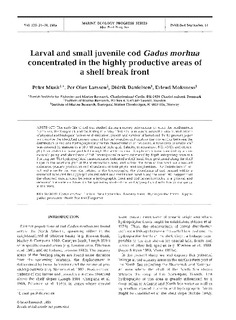| dc.description.abstract | The early life of cod was studied during a survey programme covering the northeastern North Sea, the Skagerrak and the Kattegat in May 1992. Our aim was to asses the interrelated effects of physical and biological factors on distribution, growth and survival of larval cod. In the present paper we describe the identified nursery areas of larvae/juveniles and analyse the connection between the distribution of cod and hydrographical (frontal) characteristics of the areas. A total area of 67000 km(2) was covered by stations in a 10 x 10 nautical mile grid. Salinity, temperature, NO3+NO2 and chlorophyll concentration were profiled through the water column. Zooplankton were sampled by a submersible pump and abundance of fish larvae/juveniles were estimated by depth-integrating tows of a 2 m ring net. The hydrographical measurements indicated a shelf break front positioned along the shelf slope in the southern part of the investigation area, and within the zone of the front we observed enhanced primary production and abundance of both phyto- and zooplankton. The distribution of larval and juvenile cod was also related to the hydrography, the abundance of cod peaked within a restricted zone and the aggregations extended as a continuous band along the front. We suggest that the observed concurrence between a hydrographic front and cod larvae/juveniles is a general and recurrent phenomenon based on the spawning habits of cod and aggregation due to flow convergence at the front. | en |
